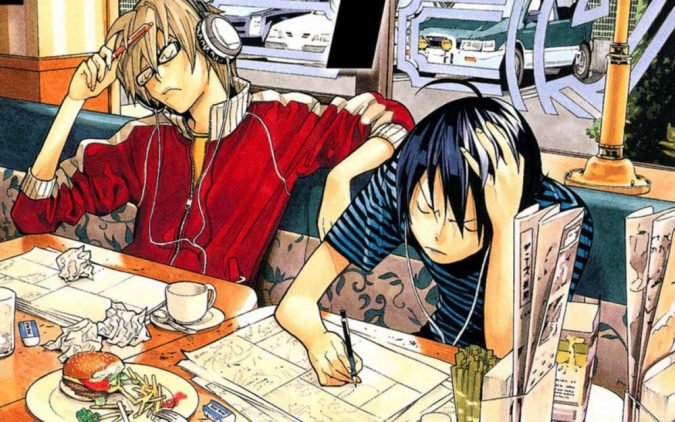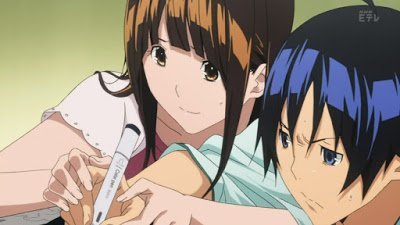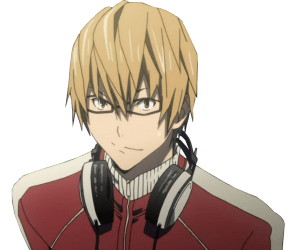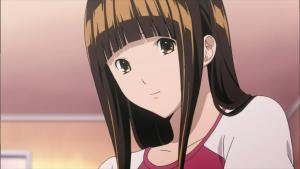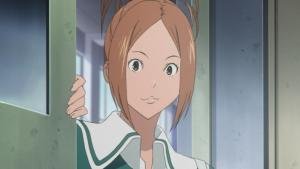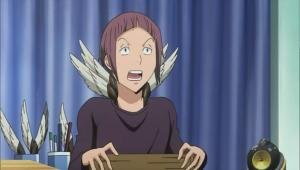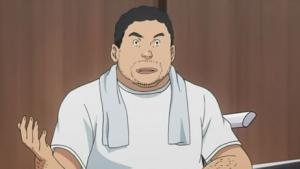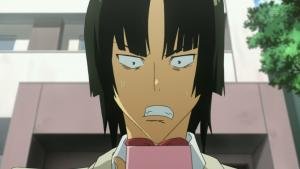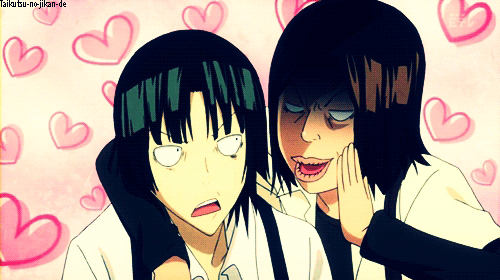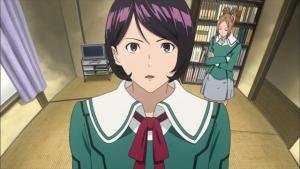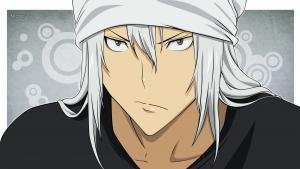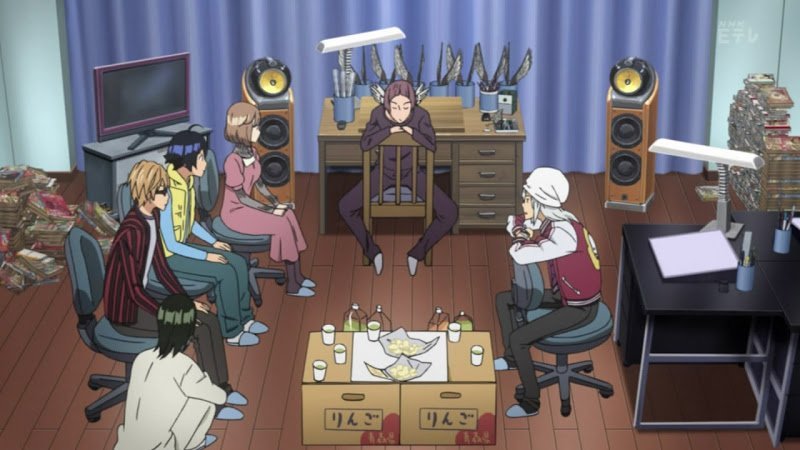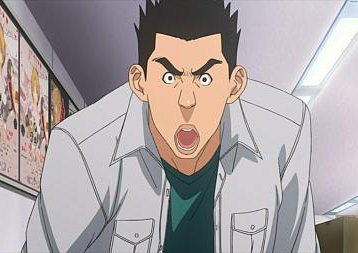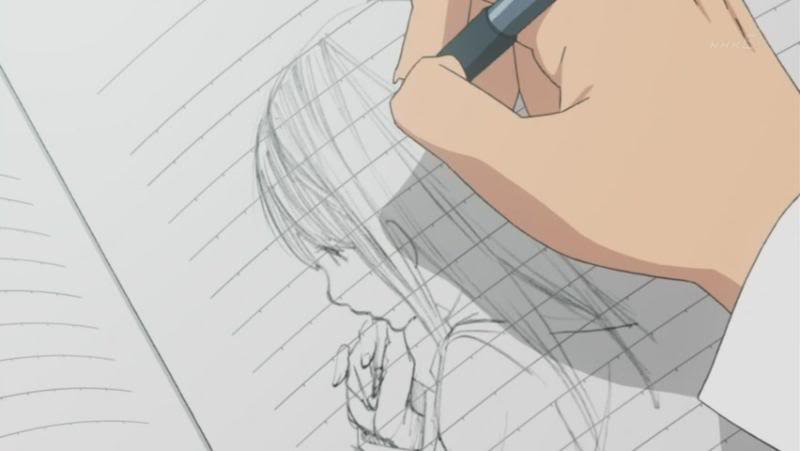Have you ever read a Shounen JUMP manga and wondered how it ended up getting in the magazine? Have you wondered what those survey cards were for or why a manga you thought was good suddenly disappears from the magazine? If the answer is yes to any or all of those questions, then the next show on my list to review will provide you with a great insight to that all while giving you an entertaining atmosphere.
Of course, I’m talking about Bakuman.
Let’s roll!
The Story
First off, a lot of people may not know this, but Bakuman is actually an acronym that stands for Bakuchi Manga, which for those who don’t speak Japanese, means Gambling on Manga. I bring that up because that is what the entire series is all about.
Our story focuses on two middle schoolers: Moritaka Mashiro and Akito Takagi. One day, Mashiro forgets his notebook at school and Takagi happens to snoop through it, discovering that Mashiro is quite an amazing artist. Takagi just happens to be an amazing writer and he asks Mashiro what he thinks about creating a manga together. Mashiro initially turns Takagi down, but they eventually agree to collaborate and create something. This, however, doesn’t sit well with Mashiro’s mother because of the fact that Mashiro’s uncle was also a manga artist, but he never really had that one huge major hit that gained him any major notoriety. In fact, he spent so much time trying to perfect his craft, he eventually passed away from overworking himself and Mashiro’s mother didn’t want that happening to her only son. However, Mashiro’s grandfather steps in and actually encourages Mashiro to follow his dreams and gives Mashiro the approval against his mother’s wishes.
So right off the bat, we get a sense of what the life of a mangaka (manga author) is like and how demanding it really can be. It often makes you wonder when you read about a mangaka going on hiatus due to health issues if it’s simply just something like the flu or something more.
With all of that aside, Mashiro also has a love interest in all of this: Miho Azuki. Once Mashiro and Takagi decided their future was in manga, Mashiro pulls a bold move and goes to Azuki’s house and asks her to marry him, but only when they all accomplish their dreams. It should be noted that Azuki’s dream is to become a voice actress so their dream is for Mashiro to make a manga and have it get turned into an anime and have Azuki be the voice for the lead heroine of said anime. In fact, in order to drive home this point, Mashiro and Takagi operate under the pen name of Ashirogi Muto. It combines all three of their names and translates to “May our dreams come true.” It’s a rather nice, yet clever, touch if you ask me.
While the above summary is just scratching the surface of the many layers to this story, any way you look at it, this is a slice of life anime with some romance and comedy mixed in. It’s not a full romantic comedy like Toradora was, though. The main focus is the story of two middle school students and their journey through high school and then college while honing their craft to become manga artists for Shounen JUMP magazine. The romance takes a back burner, surprisingly, but the way it’s pulled off doesn’t really make it seem like it’s in the background. They don’t let you forget that Mashiro and Azuki have a thing for each other and they even have instances where they end up having to break their pact of never seeing each other until their dreams come true.
The times where they are forced together will give you that “d’awwww” moment as they are just too damn cute for their own good. It’s not like a typical anime romance where they get embarrassed, run away, call each other idiots, or hit each other, but rather worked to resemble a more realistic scenario. Sure they blush, but they often times are shy around one another because the love between them afflicts them like it does any other normal human being. They do end up talking normally once they warm up to each other and that’s what makes their relationship all the more realistic than what you are accustomed to in normal shounen animes.
While we have Ashirogi Muto’s journey along with Mashiro and Miho’s romance being the main focal points, there are plenty of other side stories that are divided into several arcs, each bridging and tying together the overall story beautifully. I should also note that the story of Bakuman is almost a pseudo autobiography of sorts for the manga’s creators. You might recognize the names of Takeshi Obata and Tsugumi Ohba because they are the same duo that teamed up and created the critically acclaimed hit, Death Note. Obata did the artwork for Bakuman while Ohba wrote the story, much like how Mashiro does the art within the series and Takagi writes the stories. In fact, Takagi bears a slight resemblance to Light Yagami.
The anime does take a few shortcuts, however, as they shorten some of the manga’s source material, and in once instance, they skip over an entire story arc, but realistically, the arc they did skip over wasn’t really needed at all and even I felt that it was something akin to filler when I read it in the manga. If you do plan on doing a marathon for this anime, you’ll be in for a bit of a haul as the show aired over three years and three seasons with 25 episodes per season, giving you a grand total of 75 episodes to watch.
Despite the shortcuts, it is a highly enjoyable anime. I think my favorite part of it all was Team Fukuda. Essentially, they make up the bulk of our characters and are all young and aspiring manga artists and their collective story is pretty interesting. They have this unique rivalry between them, but at the same time, even though they are trying to defeat each other, they also encourage each other and help one another out to ensure that they all succeed. Their goal is to change the face of Shounen JUMP forever and the essence of Team Fukuda shows what a healthy, friendly rivalry is all about. It’s like saying “I really hope you do well and you make it, but make no mistake.. I’m not going to lose to you.”
Another favorite story arc was the first Nanamine arc. Some people might actually disagree with me here because I know there are some that just couldn’t stand the Nanamine character and while I did have a bit of disdain for the character, I was able to look beyond it to see the message that Ohba and Obata were trying to convey. The reason why I like this so much is I actually wanted to create my own manga at some point and while my artistic skills are “good”, they are nowhere near the level of a manga artist. I would probably be a lot better at writing the story and doing the digital coloring rather than drawing everything out. One of the most popular ways to get yourself noticed, if you do end up making a manga, is to self publish it on the internet, but there are just some ways you don’t go about doing it and Nanamine’s method is one of those ways. He, essentially, grabs fifty random strangers off the internet and have them brainstorm and feed him ideas for his manga. He then takes the best ones and creates it, passing it off as his own work. He does it to show that you don’t need to go the traditional route of having an editor at a big magazine company in order to become famous (even though he is assigned an editor with no backbone to stand up to him.) While that mindset is true, the way Nanamine goes about it is completely and utterly wrong and it makes him a pretty damn good villain in the show.
In fact, I’ll spoil it because Nanamine’s second arc is what was left out of the anime. After Nanamine was defeated in the popularity polls, and his manga gets cancelled, he uses his father’s vast wealth to start his own fly by night manga company. He took his concept of gathering people on the internet and brought it to real life where he hires people off the street to read and critique manga and use them as think tanks. He then takes those ideas and hands them to washed up manga artists to get them published once again, all for the sake of trying to beat, what he calls, a broken system. Of course, in the end, he loses at that, too, and fades away into the sunset, never to be heard from again. I think a lot of people breathed a sigh of relief once Nanamine was gone for good. We got the conveyed message the first time around, adding in a second story arc wasn’t really needed and was pretty much overkill. Plus, if you’re doing a marathon session with the manga, you’ll find that Nanamine makes his return sooner than you would like to see him, but I digress.. this is an anime review.. not a manga review.
If there was one running theme throughout this entire series, it’s failure. While in the end, it does feel like a Cinderella story, it does teach you that you’re not going to be successful right away. You will fail and you will fail a lot, but the difference between making it and not is to not give up when you fail, but to try even harder until you succeed. Ashirogi Muto fails at their one shot, then their first series fails, then so on and so on. Part of the problem is they start out immature and just want to create a hit right away and get that anime deal signed so Mashiro can get married. Then they soon learn through failure that it takes a lot of hard work and determination and you get to see their transformation from those rookie, energetic, trouble-causing kids into well-respected and mature manga artists. I think it’s a great overall life lesson to accompany an overall great anime!
But what is an anime without its cast of characters? Let’s move on!
The Characters
Moritaka Mashiro
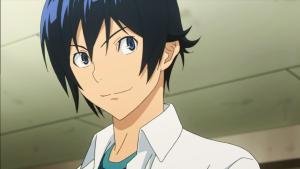
Mashiro is one of your two main characters and, well, he’s about as plain as plain can come. He’s starts off as a normal teenager who loves wasting time playing video games. He’s stuck in a rut in his life and when Takagi comes along and gives him that push to become a manga artist, his entire life flips upside down. While his life flips, he pretty much keeps the same persona throughout the entire series, minus the unmotivated psyche. He’s straight forward, hard-working, and diligent. He’s not afraid of failure and he is willing to work real hard to achieve his goals (and in one instance, just a bit too hard). His interactions with Azuki are downright cute and shows one of the most human sides to romance in anime.
Akito Takagi
Here is your second main character and he is, essentially, a Mashiro clone in terms of personality. The nice thing about Takagi and Mashiro, though, is they really feed off one another. They care about one another and are always there to offer encouragement. While they seem very cut and dry, they do have their own personalities. Takagi is a little more quirky than Mashiro, but he’s not really a comic relief (in fact, he dislikes writing comedic scenarios which goes over well when they’re asked to write a gag manga). He’s as serious about making it in Shounen JUMP as Mashiro is so the comic relief is mainly handled by the secondary characters. Takagi also gets his own love interest in the show as well, but more on that later.
Miho Azuki
This is your first major supporting character and Mashiro’s love interest. Her dream is to become a voice actress and you don’t really see all that much of her in the anime, nor the manga. She’s always off in the background and you never really know how her career or her dreams are progressing until Obata and Ohba want you to know. In fact, you’ll go a few story arcs without ever seeing Azuki and sometimes you wonder if she’s even still there, but just when you think she might have become an afterthought, she’s pulled back into the story and the romance is furthered. Her character is your typical girl next door. She’s sweet, she’s warming and caring, and she seems the most down to earth out of the entire lot of characters in the show. In fact, she also acts as a voice of reason for Mashiro at times. She also has this aura about her that when she’s on screen, you really want to watch her to see what happens. Using her sporadically like that and then bringing her back creates that atmosphere that always makes you wonder if she will talk to Mashiro.. if so, what will she say? Will they see each other? How is her dream going? It’s like catching up with an old friend. You want to ask so many questions, but you end up sitting back and just watching what happens and hope that her brief appearances is enough to satiate your appetite until the next time she appears on screen.
Kaya Miyoshi
From one love interest to the other. Miyoshi is Miho’s best friend and one day, decides to interject herself into the lives of Mashiro and Takagi. Miyoshi is the very opposite of Miho as she’s very outgoing and really kind of ditzy. She’s clumsy and makes a lot of mistakes and just reminds me of that one girl that’s always loud-mouthed and too energetic for her own damn good. While she does sound annoying, they kind of give her some limiters so that she never really ends up that way. Takagi reluctantly decides to go out with her and she ends up believing in Takagi’s dream so much, she becomes an assistant at their studio… well.. an assistant to the best of her ability which is limited to tracing over the lines with a black marker, but hey! She can make an awesome cup of coffee!
Eiji Nizuma
Many felt that this character would be the main antagonist of the show, and in a way.. he is, but not directly. Nizuma is the child prodigy of manga. He can create stories off the top of his head with very little thought that can rival what some of the professionals have been doing for years. He is the main rival of Mashiro and Takagi, but Nizuma is also a fan of their work at the same time. Nizuma is also… for the lack of a better term… extremely eccentric. He speaks mainly in manga puns, makes noises like a five year old playing with his toys while he draws his manga, and makes some of the most ridiculous demands, but underneath that, he is a certified genius when it comes to manga and can even predict the success and failure of a manga just by reading a single chapter. Nizuma is tied as my favorite character in this entire series… I’ll reveal the second one in a little bit. He just brings about a freshness to the overall atmosphere and he really fills the “major rival” or even “final boss” role of the series even though he’s not really an enemy. Pulling off the good/bad guy persona with a character is not an easy task, but Obata and Ohba manage to nail it perfectly with Eiji Nizuma. I’m going to make a bold statement and say that this one character makes the entire series. Without Nizuma, I don’t think Bakuman would have stood a snowball’s chance in hell of being as good as it was.
Takuro Nakai
Now we go from one extreme to the next. Fat. Vile. Disgusting. Those three words pretty sum up this guy. Nakai is that character that you hate, but you feel sorry for at the same time. He’s a late bloomer in the fact that he started off doing manga at age 33. He’s been an assistant his entire life and he’s amazing when it comes to drawing background art. He’s overweight and he’s kind of a loner, but he also has a dark side dealing with perversion. When he’s partnered up with Yuriko Aoki, he finally gets his first taste of succeeding as a manga artist. So much so that it goes to his head and blinds him to what’s really important. It’s also the catalyst for him to become obsessed with Yuriko to the point where you could say he’s reached stalker levels of creepiness. It gets so bad that he gets driven away from being a manga artist only to return as Nanamine’s top advisor where his ego really goes out of control. Because he was so desperate to get back into manga and get out of his parent’s house, Nakai pretty much takes the job with Nanamine, but it’s this experience that makes him realize some of the errors of his ways. Nakai wasn’t one of my favorite characters.. in fact, I didn’t really like him all that much, but he was needed because he brought that dark balance to the group.
Yuriko Aoki
Since I mentioned her with Nakai, I’ll touch upon her next. There really isn’t much about her, to be honest. She’s actually a novelist who wanted to try her hand at making a manga. Her attitude is very level-headed and proper. One might think she might have been the stuck up type at first, but she’s just cautious because she doesn’t really know what she’s getting herself into with manga. Once she gets a taste of it, she kind of relaxes and opens up… much like some people do when they meet someone for the first time.. you tend to hide yourself until you get to know each other, then slowly you begin to open up. That’s how I felt this character presented herself and while her role is pretty minor, she does serve a purpose in the show… mainly as a test to Takagi and Miyoshi’s relationship. Aoki doesn’t try to steal Takagi away, but they do inadvertently give off the feeling that they are having an affair. It’s a nice mix of comedy and drama at the same time and it wouldn’t be possible without Aoki.
Kazuma Hirumaru
This guy… THIS GUY RIGHT HERE. Hands down… is the one who is tied with Eiji Nizuma as my favorite character in the series and he is such a small-role supporting character. Here is one of your comic relief characters in the fact that he doesn’t want to draw manga despite the fact that he’s good at it. His dream it to make a lot of money, retire early, and just be lazy because he believes that any work is too hard for him to handle, but his editor is such a manipulating bastard, that he convinces Hirumaru to continue drawing. In fact, here… have a .gif of one of those times!
He promises Hirumaru fame and riches, exploiting his desires in order to make him draw manga. He even promises to deliver his crush, Yuriko Aoki, to him in the form of a tea date just to get him keep drawing manga. In fact, this tactic works so well that Hirumaru is the first one out of Team Fukuda that’s not named Eiji Nizuma, to get an anime. The situations and scenarios that Hirumaru gets himself into are downright hilarious and is probably one of the best written characters in the entire series. In fact, when he finally asks Aoki out, it had me yelling at my computer “DO IT! DO IT HIRUMARU!”. His character is just that damn good.
Aiko Iwase
What you thought Aoki would have been in the beginning is exactly what Iwase is. She’s that stuck up person who believes that novels are better than manga… that they carry with them more sophistication than that of manga and she aims to prove that… by becoming a manga artist. While that sounds backwards, I should point out that Iwase loved Takagi in high school, but mainly because the two of them got the highest grades and were at the top of their respective classes. When Takagi chose Miyoshi, Iwase felt that Takagi was wasting his potential in a mate. She even feels this when she discovers Takagi is doing manga, feeling that he’s too talented to waste it away doing something like that. This is the sole driving purpose for her to become a manga artist… so she can outclass Takagi and show him that a manga in novel form will be better than anything he’s ever written. In fact, she becomes a pseudo-member of Team Fukuda even though she doesn’t care about their ideals. She is a strange fit to the cast, but it’s just another rival added to the mix.
Shinta Fukuda
As aforementioned, there was a group called Team Fukuda and this is the character that started the group. Fukuda looks like a punk off the street and even his assistants, especially with one of them sporting a Mohawk, give off that vibe, too, but Fukuda is genuinely caring in the fact that he will help his friends no matter what, but he is highly competitive and someone who hates to follow the rules. He vows that he will change Shounen JUMP forever and convinces Mashiro, Takagai, Nizuma, Nakai, Hirumau, and Aoki to do the same. Together they make up Team Fukuda and they are each other’s backbones as well as back breakers. It really is a unique group as they all have a common goal… to change JUMP… but at the same time, they all want to be the number one artist in JUMP to be in that position to do it. I really liked the Fukuda character a lot. A lot of people see him as brash, but I see someone with an unmeasurable amount of drive and passion which makes him the perfect leader for the group.
Team Fukuda having a meeting
There are a lot of other characters such as the editors (especially Akira Hattori who is Mashiro and Takagi’s editor), the chief editor Hisashi Sasaki (who was also Mashiro’s uncle’s editor during his days as an artist), and Nanamine (who I touched upon in the story section), that fill out the rest of the cast. The editors each have their own personalities, but the story focuses a lot more on Team Fukuda and the other authors. There’s also the assistants to all of the authors which makes this a very large cast, but are all mostly generic supporting characters with the exception of Mashiro and Takagi’s assistants, who are given a little more personality. The only ones that really stand out among them are Shun Shiratori and Shoyo Takahama, who both end up getting their own mangas.
With a cast this large, you’d think you would feel overwhelmed, but the series does an amazing job of not throwing them all at you at once. Little by little, piece by piece, they are all introduced and sometimes when some are introduced, others are taken away so that there is always a happy medium in the number of characters on screen or involved in a story arc. While some really stand out, the others which are small supporting characters, really shine and are not easily forgotten. It’s a testament to how well this show develops such a large cast and they do an amazing job keeping tabs on the characters once they are established and developed. It also does a great job of making you care about the characters in some form or another. Whether to sympathize with a character, or you cheer them on, or you just absolutely loathe and hate them, they always give you a specific reason to invest some time into that character rather than just throwing it to the side into the support pile to be fed random lines.
The Art & Animation
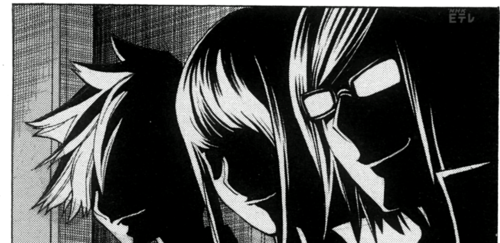
I usually start with the art, but I’ll talk about the animation first which, sorry to say, isn’t anything that’s going to blow your socks off. The animation isn’t bad, either, though because everything does seem to fit and flow nicely, but nothing really stood out as eye catching and there’s a good reason for that… it wasn’t meant to do so. This isn’t a shounen battle anime, there isn’t flashy particle effects and explosions or what have you.. this is a down to earth, slice of life anime and it doesn’t need to have fancy CG or the sort to get itself over. Everything here is perfectly fine and it helps create the atmosphere that it’s meant to create. The animation does its job and that’s all that is important here.
I should note, however, that there are some shounen anime style scenes in this show. When Crow (which is Eiji’s manga) gets an anime, they show scenes from that, as well as Hirumaru’s Otters 11 anime. Things like that are nice because you don’t get to witness that while reading the manga so seeing those extra scenes in the anime is really unique and amazing.
The art here is what really shines and when I say art.. I’m not talking about the character designs or the backgrounds, but I’m talking about the manga within the anime. Everything is given very high detail to make it look like authentic manga within the show. Whether its Mashiro and Takagi’s first work Money & Intelligence, up to their big smash high PCP (Perfect Crime Party), they give you some nice shots from the pages of their manga. They also do the same with all of the other authors and when you see those manga pages, it’s really something to behold. A lot of shows would usually skimp over these details and make a manga page generic looking, but this show goes full out on the detail to make the pages look authentic as possible.
The character designs aren’t really much to write home about, but even though the designs are drab, they find a way to stand out and be unique to the point of instant recognition. When you see Mashiro, you know he’s Mashiro… when you see Fukuda, you know it’s Fukuda. There is never a mistaken identity when it comes to the characters, but at the same time, there’s nothing about their clothing or design that makes them seem over the top and larger than life, but when you have a slice of life anime, something like that is to be expected. It’s kind of like an atmosphere where if you stuck Naruto in the middle of this cast, he’d stick out like a sore thumb, but at the same time, you could still point out and name each person of the cast despite the distraction.
Overall Thoughts
This is still one of my favorite series. Obata and Ohba have another hit on their hands even though the fan base wasn’t too pleased with the omission of a story arc and the shortening of some of the things that happened in the manga, but the reality is, you can’t have perfect adaptations because you have to deal with time slots, the length of an episode, how many episodes the anime is contracted for, etc, etc. There’s a lot of things to consider and if the show isn’t as popular as the manga and suffers in the ratings, you’re not really guaranteed a renewal or new season, so if that’s the case, you don’t want to end up ending the show in a weird spot so you have to kind of plan for what you’re given and in most cases, that means shortening some of the material.
Despite that, it is still highly enjoyable. The characters are phenomenal, the overall story is simple, but it leaves you wanting more at the end of every episode… a sign of a good anime. It makes you care about what’s happening and entertains you along the way. You get to experience the highs and lows of trying to make it as a manga author and they try to accomplish this by making it as realistic as possible.
One thing that confused me a bit was the changing of the name of the publishing company in the anime. In the Bakuman manga, they clearly state that they are trying to get into Shueisha’s Shounen JUMP magazine, but in the anime, it’s referred to Yueisha’s Shounen JACK magazine. I don’t understand the reason for the change since Bakuman was serialized in JUMP in real life, but I digress.
Bottom line… this is definitely worth the watch. A lot of shows about anime and manga have tried to replicate what you got with this show, but none of them really came close to it. This really is one of a kind. If you are familiar with Obata and Ohba’s work, then you’ll even appreciate some of the nods they give to themselves throughout the series… like when Mashiro begins to draw, he’ll mimic Light Yagami writing names into the Death Note, or how they poke fun at themselves for introducing Near into the Death Note series and how that wasn’t the best idea. It’s kind of entertaining to watch the creators take shots at themselves!
Overall, I’m going to give this a 9 out of 10. The only thing stopping me from giving this a perfect score is the shortened manga material as well as the omission of one of the story arcs, but as I explained, sometimes that’s a necessary evil and it doesn’t detract from the quality of this show.
Agree with what I wrote about Bakuman? Disagree with anything I said? Have recommendations for a review in the future? If so, let me know by sending all of your thoughts to joshpiedra@theouterhaven.net. Also, if you feel inclined to do so, follow me on Twitter @TheAnimePulse
Until next time,
Ja ne!
Bakuman
Summary
A great slice of life anime that showcases the journey of two teenagers in becoming successful manga artists


